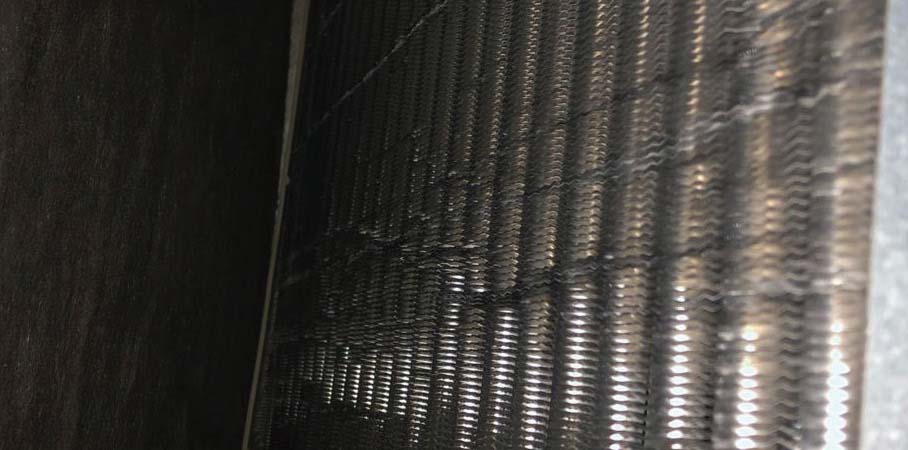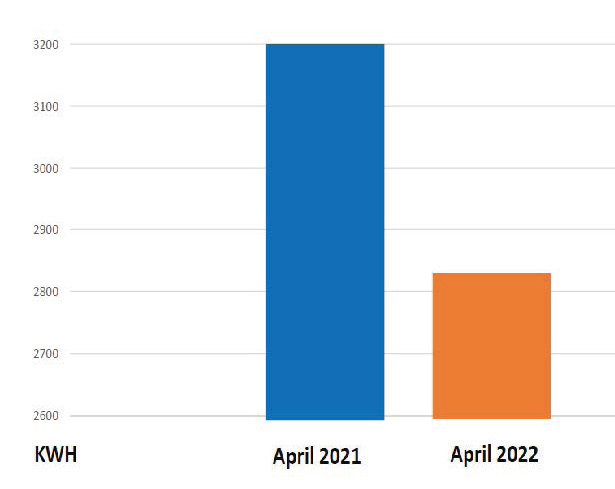Ultraviolet (UVC) light disinfection dominated IAQ news the last two years, as it was widely used to effectively help combat the virus that causes COVID-19. As the pandemic wanes, building owners and facility managers are once again embracing one of the technology’s original benefits of increasing HVAC coil and equipment performance and efficiency.
Aside from the ability for UVC disinfecting light to neutralize SARS-CoV-2, the virus that causes COVID-19, it’s well documented that 254-nanometer UVC lamps maintain HVAC system interiors and coils up to 99.999% free of accumulated contaminants. Cleaner coils promise better efficiency by delivering more efficient heat transfer across the coil with reduced static pressure.

GREATER EFFICIENCY: Cleaner coils promise better efficiency by delivering more efficient heat transfer across the coil with reduced static pressure. (Courtesy of Avison Young)
Proving this premise, I ran my own efficiency tests on an Atlanta-based property.
The one-year-long controlled study resulted in a 12% year-long energy efficiency improvement on air handlers outfitted with UVC lamps. The tests were designed to investigate UVC retrofit funding approval for other air handlers within a 14-story commercial high rise.

STUDY RESULTS: The one-year-long controlled study resulted in a 12% year-long energy efficiency improvement on air handlers outfitted with UVC lamps. (Courtesy of Avison Young)
Preventing accumulated contaminant buildup in HVAC systems is already a proven fact, and I wanted to prove UVC also results in energy efficiency with a feasible return on investment (ROI).
I chose two of the building’s comparable 80-ton, self-contained, water-cooled unitary device (SWUD) air handlers manufactured by Trane. They condition their own identical 32,000-square-foot floor space via variable air volume (VAV) boxes and powered induction units. One floor’s air handler became a test unit and was retrofitted with four 48-inch-long, coil-mount UVC disinfection systems, manufactured by Fresh-Aire UV. Factory engineers specified the Fresh-Aire UV ‘CORE’ system for proper sizing and dosage using proprietary BlueCalc UV specification software. Other technical assistance was provided by EC Electric and energy services contractor Engineered Technical Services Inc. The other floor’s air handler served as a control group for the test.
The test unit was outfitted with UVC systems mounted in the plenum above the coil. Each air handler was monitored with kilowatt meters.
While the findings are based on real-life operating equipment, laboratory studies have proven similar results. For example, a thin film of accumulated build-up acts as insulation on HVAC system coils and reduces heat transfer energy efficiency. Studies have also proven that just a .002-inch-thick coating of long-term accumulated buildup material on coils can negatively impact heat transfer and reduce the free area increasing air velocity up to 9%. The result is a higher static pressure across the coil that requires more fan energy. Eliminating accumulated buildup can result in up to a 30% cooling capacity increase when compared to a fouled and dirty coil. Furthermore, accumulations can also adhesively attract additional dirt that ordinarily wouldn't accumulate on a clean coil.
The 12% energy savings breaks down to:
- The UVC air handler used 56,169-Kwh during the year-long test, which was 12% less Kwh than the control air handler;
- Utility electric cost of .12-cents per kW x 56,169 Kwh = $6,740 per year;
- $6,740 ÷ 12% = $808 per year per air handler; and
- An additional benefit is reduced cleaning labor and chemicals at an estimated savings of $1,408 per year per air handler based on national averages.
While both units were identical, the test unit’s 20-year-old fan motor was original, and the control unit’s fan motor had recently been replaced with a newer technology-powered efficiency model.
The test results might have been slightly more impressive, because I accounted for this variance with a very conservative estimate. The variance is noticeable on a monthly chart comparison of both air handlers’ Kwh use, because both were cleaned before beginning the study. The control unit’s newer technology proved more efficient in the first three months of comparison after cleaning. I theorized that maintenance trends toward less acidic, more environmental coil cleaners don’t completely clean and brighten coils. Consequently, the test unit made efficiency gains over the control unit only during the test’s last nine months as the UVC lamps dissolved any remaining accumulated build-up after the initial cleaning.
Not included in the payback benefits is the decreased maintenance labor/chemicals of cleaning a coil, drain pan, and condensate line at approximately $1,408 per year per air handler.
“Over the last few years, UVC manufacturers have seen increased IAQ awareness, and we find it’s important to revisit the IAQ fundamentals and how fouling can impact equipment efficiencies,” said Aaron Engel, vice president, business development, Fresh-Aire UV. “Treating the air but not keeping HVAC equipment clean will eventually reintroduce contamination back into the home or building. UVC disinfection is part of a layered strategy for protecting the equipment, maximizing HVAC performance and efficiency while also improving occupant IAQ.”
I used a UVC light system in my residential 3 1/2-ton HVAC split-system, which inspired me to test the commercial building for possible efficiency advantages. Two years ago, my home system’s humidifier leaked. Amid the cleanup, I noticed the 20-year-old coil and interior components, including the insulation, were pristine due to a UVC lamp he installed. Summertime humidity in southern states can lead to corrosion and ultimately premature failure in less than 12 years, but the system was still operating for more than 20 years.
I’ve seen some residential units where the evaporator coil is really nasty with contaminants after only a few years. When other unproven disinfection technologies emerged amid the COVID-19 pandemic, I remained a proponent of UVC, which had already been proven through studies as effective for neutralizing SARS-CoV-1, influenza, and other viruses. UVC is also recommended by ASHRAE and the U.S. Centers for Disease Control and Prevention (CDC) for neutralizing microorganisms.
Now with a study proving energy efficiency, I hope to outfit other air handlers with UVC in the future to improve efficiency.


Report Abusive Comment